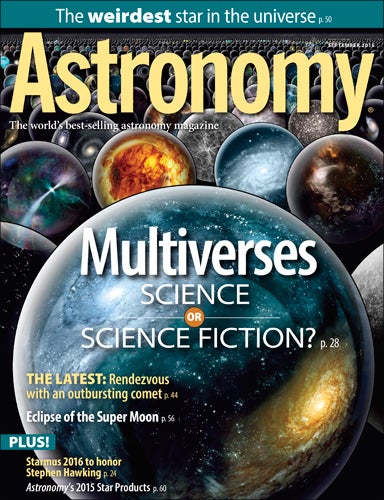Video FAQ page
In “Multiverses: Science or science fiction?” Contributing Editor Bob Berman explores the most popular multiverse models, from the mostly discarded string theory, with its myriad hidden dimensions, to quantum theory’s many worlds interpretation of endlessly branching decision trees, to the ultimate ensemble, which claims that anything that is mathematically possible will happen in one alternate universe or another. Berman discusses how cosmologists search for evidence of these multiverses and whether the models can be proven at all. Does a theory, no matter how mathematically rigorous, count as science if no test of its predictions is possible?
To come to your own conclusion about the reality of multiverses, pick up the September 2015 issue of Astronomy magazine, on newsstands August 4.
“The weirdest star in the universe”
An elusive and odd star known as a Thorne-Żytkow object (TZO) has eluded observational astronomers since theorists first proposed the idea 40 years ago. The theory explains how a TZO forms, when a dense dead star merges with a puffy red dying sun, but finding such an object proved a puzzle — until now. Science writer Yvette Cendes reports on how astronomers attained their first detection of a TZO in “The weirdest star in the universe.”
“Rendezvous with an evolving comet”
The European Space Agency’s Rosetta spacecraft has settled into its orbit and scientific duties around Comet 67P/Churyumov-Gerasimenko, and its lander partner Philae has awakened after a long hibernation, from which scientists were unsure if it would ever return. While Philae slept, Rosetta has been returning breathtaking new science, mapping the comet’s surface in exquisite detail, and capturing surprising details about its activity. In “Rendezvous with an evolving comet,” Senior Editor Richard Talcott reviews Rosetta’s most intriguing discoveries so far.
“Eclipse of the Super Moon”
September serves up the largest Full Moon of the year, known as the Super Moon, which coincides with the Harvest Moon and the finale in a closely spaced series of four total lunar eclipses. As such, astronomer and science communicator Dean Regas predicts in “Eclipse of the Super Moon” that the public and general press will go wild. Rather than quash enthusiasm for a simple astronomical coincidence, Regas encourages astronomy lovers to embrace the occurrence as a sky event for all ages and backgrounds.
September sky events visible without optical aid
- September 13 — Observers across the southern tier of African countries and parts of Antarctica will witness a partial solar eclipse.
- September 21 — Venus reaches peak brilliance for the year, shining brightly in the morning sky.
- September 27/28 — Viewers across the Americas can witness a spectacular total eclipse of the Super Moon.
Also in the September 2015 Astronomy
- “Starmus will honor Stephen Hawking in 2016”: The third Starmus Festival, a celebration of science, music, and the arts, will take place in Tenerife, Canary Islands, Spain, in 2016 and will celebrate the life and accomplishments of famed physicist Stephen Hawking.
- “Astronomy’s sixth annual Star Products”: Phil Harrington overviews 35 favorites from the past year of releases from the top manufacturers of astronomy related hardware, software, accessories, and teaching tools.
- “The Sky this Month”: Exclusive star charts will guide you through September’s night sky.
- The September issue also features Snapshot, Breakthrough, Astro News, Ask Astro, Bob Berman’s Strange Universe, Glenn Chaple’s Observing Basics, Jeff Hester’s For Your Consideration, Stephen James O’Meara’s Secret Sky, Astro Sketching, New Products, Letters, Web Talk, and Reader Gallery.
Astronomy offers you the most exciting, visually stunning, thorough, and timely coverage of the heavens above. Each monthly issue includes expert science reporting, vivid color photography, complete sky-event coverage, spot-on observing tips, informative equipment reviews, and more. All of this comes in an easy-to-understand user-friendly style that’s perfect for astronomers at any level. Contact Astronomy, the world’s best-selling astronomy magazine, at 262.796.8776 or email editor@astronomy.com.










